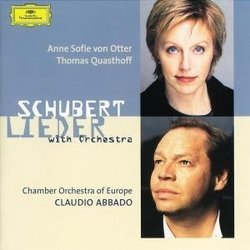| All Artists: Franz [Vienna] Schubert, Claudio Abbado, Anne Sofie von Otter, Chamber Orchestra of Europe Title: Schubert: Lieder with Orchestra Members Wishing: 0 Total Copies: 0 Label: Deutsche Grammophon Release Date: 4/8/2003 Genres: Pop, Classical Styles: Vocal Pop, Opera & Classical Vocal, Historical Periods, Classical (c.1770-1830) Number of Discs: 1 SwapaCD Credits: 1 UPC: 028947158622 |
Search - Franz [Vienna] Schubert, Claudio Abbado, Anne Sofie von Otter :: Schubert: Lieder with Orchestra
 | Franz [Vienna] Schubert, Claudio Abbado, Anne Sofie von Otter Schubert: Lieder with Orchestra Genres: Pop, Classical
|
Larger Image |
CD DetailsSimilar CDs
|
CD ReviewsA miracle indeed! Axel | USA | 05/09/2003 (5 out of 5 stars) "At last a serious vocal project with orchestra from DG! I can't find enough praise. These Schubert songs orchestrated by various composers are not easy to come by and it was a stroke of genius to put them together on one disc and have them sung by two great Lieder singers. I only knew Berlioz's orchestration of the Erlkoenig (sung in French by Charles Panzera), here we get two: Berlioz's (sung by von Otter) and Reger's (sung by Quasthoff). All the orchestrations are little gems and it would be hard to single out the "greatest hits". I was quite impressed with Liszt's orchestration of "Die junge Nonne" which sounded to me very Berliozian (maybe even more than Berlioz's Erlkoenig). Throughout the disc, von Otter sings with decidedly more operatic tone (often extremely dramatic) than Quasthoff. I won't pretend that I know what style is more appropriate for singing Lieder with orchestra but both von Otter's operatic approach and Quasthoff's more subdued one work very well here. Abbado's conducting must not be overlooked - it is beautifully nuanced and adds to the pleasure of listening to these miniatures. It is a live concert from Paris, no applause is recorded even after the concert, before the two encores that end the disc, so they come 'unannounced' (although they are listed in the booklet on a separate page) and somehow break the structure of the recital which is divided into two parts, the first belonging to ASvO, the second to TQ. I found it a bit distracting but I am sure others would complain if the applause was recorded so this only proves how tricky it is to transfer live concerts and preserve the concert's structure and atmosphere on disc. But this is a minor problem here. This disc is a real gem and I wish DG made more recordings of this kind, using these two great artists instead of spending money on the useless and repetitive opera arias recitals from young and inexperienced singers that seem to be their priority nowadays." Not a mere experiment. Osvaldo Colarusso | Curitiba, Paraná Brazil | 03/23/2004 (5 out of 5 stars) "This recording isn't a mere experiment. It's the result of a very profound research. The first track is the beginning of this fascinating path: One orchestral lied by Schubert himself. And after this Lied from the "Rosamunde" the discoveries : Schubert orchestrated by Britten , Brahms , Reger, Berlioz, Liszt, Webern and Offenbach. The most interesting orchestrations are undoubtedly : Ellens Zweiter Gesang , that Brahms scored for Four Horns and Three bassoons, Erlkönig , that Berlioz transformed in a symphonic storm, and the four delicates orchestrations conceived by the 20 years old Anton Webern . Not only the research is fascinating. The realization is also outstanding. Anne Sophie von Otter , one of the most important Lieder singer in the world. Her recordings of Strauss, Grieg, Berg, Brahms and Schubert with the excellent pianist Bengt Forsberg are among the most interesting lieder recording of the last 20 years .She sings these orchestral versions with the same sense of intimacy of a original (piano) version , with some interesting "orchestral" affinities in her emission, specially in Die Junge Nonne ( orchestrated by Liszt) and in Die Forelle ( orchestrated by Britten). Thomas Quasthoff has a more Symphonic approach . But he is capable of wonderful intimate sonorities in the four Webern Orchestrations. The Chamber Orchestra of Europe conducted by Claudio Abbado are more than mere support for the voices. The intelligence of the conductor lead this fascinating research to a very high level of intensity , always with a flawless sense of musicality." A miracle! Jean-Yves Malmasson | Villebon-sur-Yvette, Essonne (91) France | 04/19/2003 (5 out of 5 stars) "I was present to this concert in Paris where this CD has been recorded live. It was really breathtaking! A great moment of pure music, of pure emotion. Very interesting on the musicologic point of view too, it is amazing to hear Schubert's Lieder adorned with orchestral colours. Do not hesitate, get it right away! This is two of the most magnificent woices of our time and this is... the great ABBADO."
|

 Track Listings (21) - Disc #1
Track Listings (21) - Disc #1